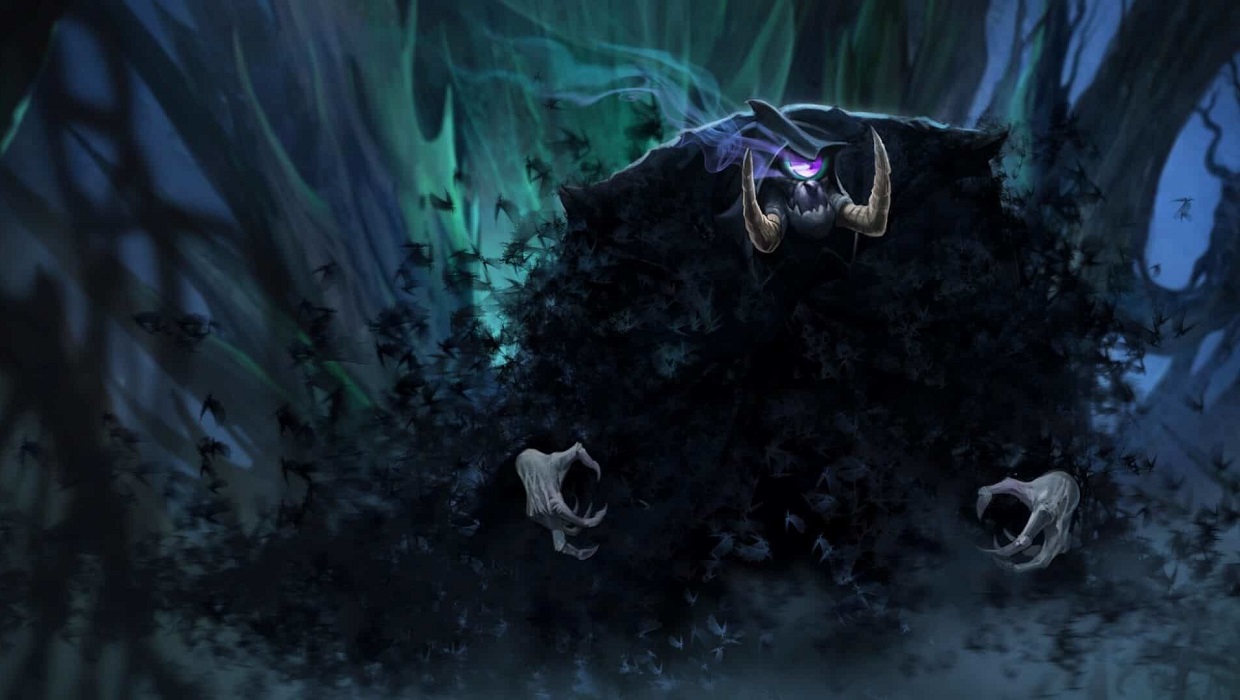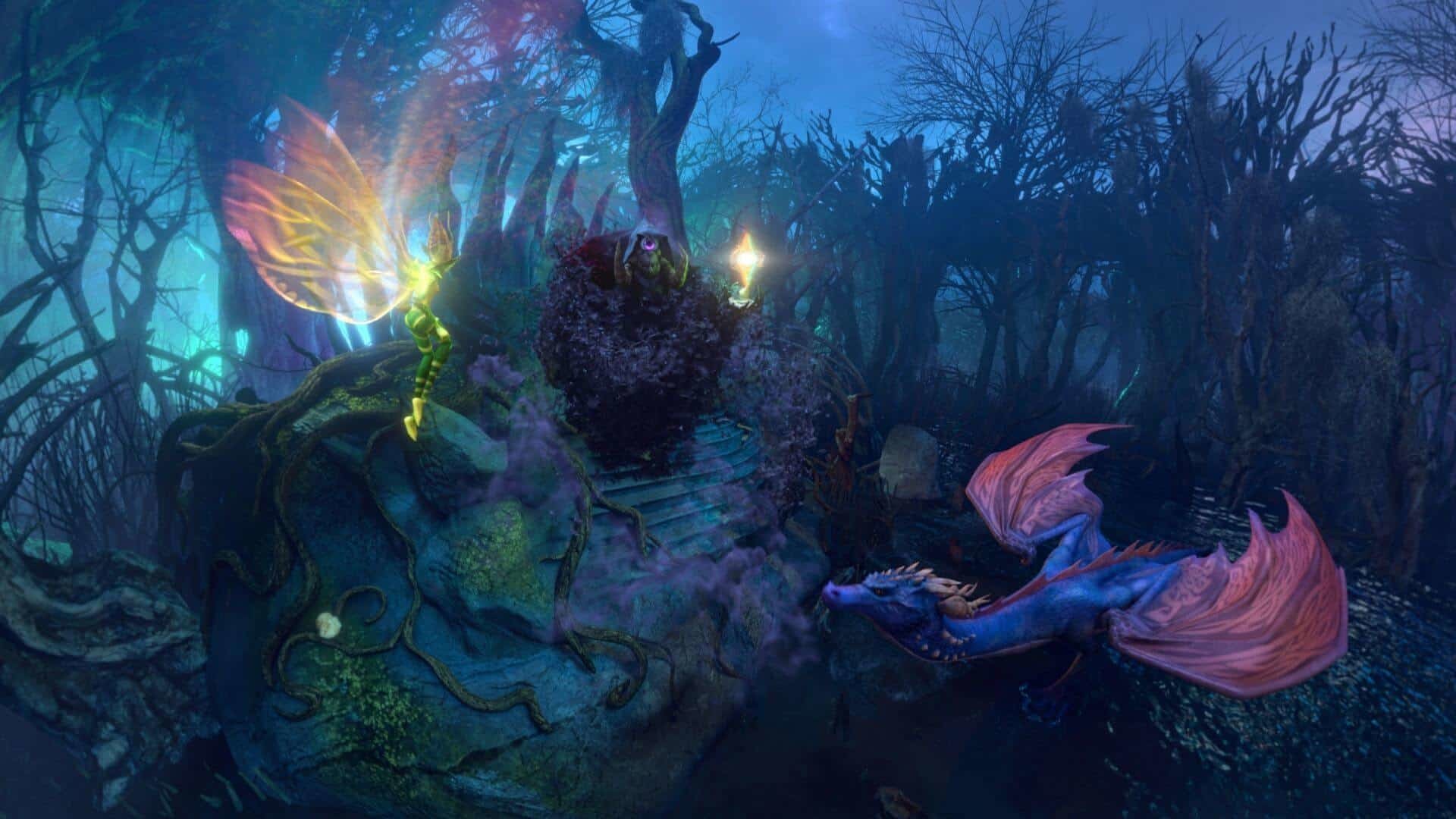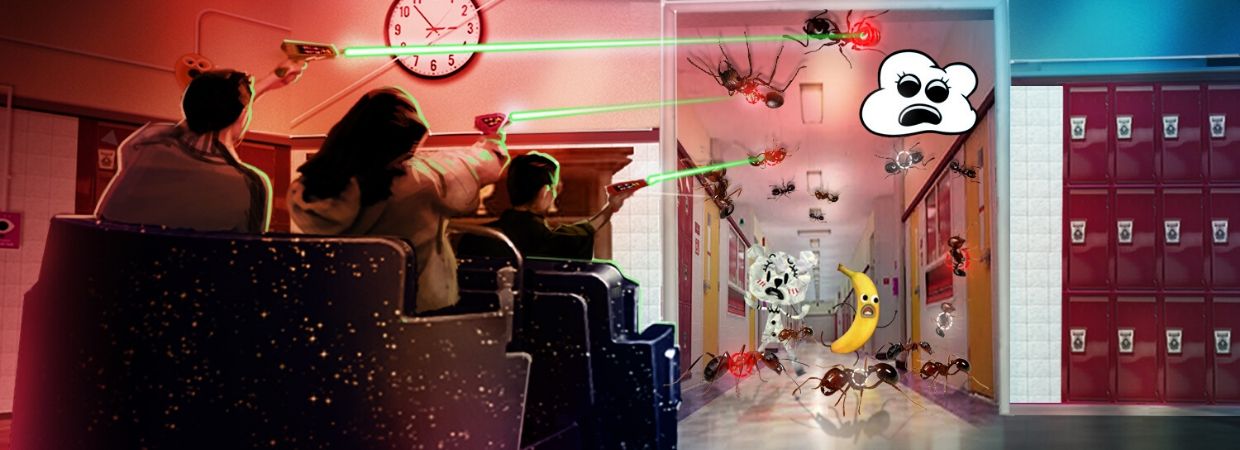Building Characters for Themed Experiences
Characters bring worlds to life.
Characters turn places into living, breathing environments. Characters ground change and evolution in emotion and consequence. Characters transform events into full-fledged stories.
Through context, perspective, and dimensionality, characters provide both the storyteller and their audience the most critical component of any narrative: the human element. Even if our characters are far from human, the role they play in the story is fundamentally geared towards the audience to whom the story is being told.
In the case of themed entertainment design, character development offers a critical anchor for our guests. In theme parks and attractions, our guests can understand the visceral danger of an explosion or the beauty and wonder of an alien world. However, to elevate the experience – to truly invite the guest into this world we are creating for them – we must create characters who inhabit the story and react to events that transpire within it in compelling and relatable ways.

Deep Sea Odyssey’s Pao Pao, a cute character that was part fish, part mechanical submarine, is a unique character that displays a lot of expression to appeal to the younger audience.
With this in mind, let’s examine what it takes to create meaningful characters for themed entertainment experiences. The truth is there’s no shortage of rich detail and backstory these characters can have. Moreover, there’s no shortage of how many talented hands and voices may participate in the process of developing any one character. The possibilities are only limited by imagination and, to be a bit more pragmatic, budget.
So, instead of walking through the ideation process, which always varies project to project, I would like to take a step back and explore at a high level the intrinsic value characters bring to themed experiences. Let's use this opportunity to focus our attention on a single, critical exercise that can jumpstart the rest of the character development process. Before all the thrilling ideation and world-building, we need to make sure we understand how these undefined characters will function within the guest experience. And for our purposes, we will say that characters created for themed experiences act in at least one of the three following roles:
- Role #1: ‘Ambassadors’
- Role #2: ‘Instigators’
- Role #3: ‘Interplayers’
1) Ambassadors
Character Development for Brands and Worlds...
When it comes to theme park design or attraction design, one role a character may fulfill is that of an ‘Ambassador’.
The spirit and setting of a story, brand, or franchise are often best symbolized by its cast of characters and their behaviors. In realms of fiction and fantasy, the Ambassador’s role often takes full advantage of this by integrating into the environmental storytelling of the surrounding park or attraction.

Some characters are so iconic to their franchise, all it takes is a simple cameo for them to fulfill the Ambassador role in a story, celebrating the entire brand for which they stand. Master Chief, Spartan 117, makes a memorable appearance at the end "The Ring Experience", a dome-theater experience Falcon's created for the traveling exhibition Halo: Outpost Discovery.
If our world features a mischievous prankster character, we may find the remnants of their handiwork in comical notes or doodles of vandalism etched into the wayfinding signage and graphics around the area. A genius but absent-minded academic character may keep their workshops cluttered and in disarray, giving us the opportunity to read their hasty notes or journal entries scattered throughout the queue. An ominous voice may be heard, warning us of the dangers nearby and setting the stage for a thrilling adventure right around the corner.
Critically, Ambassadors like this showcase the emotional context of their homes. They populate our periphery, not just our imagination. We see or hear these characters interacting with the same environment we are exploring. Their lives and personalities manifest across a wide diversity of mediums and make even the most alien and unimaginable worlds feel grounded, inhabited, and alive. When we develop characters to act as Ambassadors, we are essentially extending the world-building process. We are personifying the theme, tone, and lore of our world with an individual who thinks, acts, and makes choices based on their lives in this fiction.
The importance of Ambassadors becomes even more clear when our experience is created for a non-fictional storyline. Consider, for example, the chimpanzees our digital media team brought to life for the National Geographic exhibition: Becoming Jane.
Working with the National Geographic Museum in Washington D.C. and the Jane Goodall Institute (JGI), Falcon’s had the enormous privilege to contribute dynamic media pieces to help tell the powerful story of the life and evolution of Dr. Jane Goodall. Since she first began her groundbreaking research in Africa in 1960, Dr. Goodall has championed advocacy for the primates and other animals of our planet. In many ways, she and those she inspires act as ‘ambassadors’ of the planet, giving a voice to creatures and ecosystems that cannot speak to us for themselves.
This idea is encapsulated in Becoming Jane. Across a multitude of media pieces, the famed chimpanzees of Gombe Stream are brought to life before guests through computer generated imagery. The exhibition casts these ‘digital’ characters in a starring role throughout this themed experience, utilizing them as true ambassadors of the animal world and of Dr. Goodall’s journey.
The symbolic role they play in the experience is only elevated by the extreme level of factual authenticity that anchors their design. Their ‘character development’ was an intense, detail-driven process during which our team worked closely with the primatologists of JGI to ensure everything from the nuances of their behavior to their facial features and even vocalizations were scientifically accurate. This impeccable attention to detail and accuracy was crucial to ensuring the meaningful message of the experience was uncompromised. As such, these ‘Ambassadors’ act as perfect representatives of their native habitat and their place in the greater animal kingdom.
2) Instigators
Character Development for Story and Conflict...
If a character in an Ambassador role makes the world feel lived in, a character in an Instigator role makes the story feel alive. Instigators play a critical role in the storytelling of any given experience. These are characters who actively trigger conflict and create change in the narrative as we are experiencing it.

Balor instigates our story as the threatening villain of Busch Garden Williamsburg's VR adventure: Battle For Eire.
Classic archetypes come to mind when I consider this type of character role: the villain who threatens doom, the hero who boldly saves the day, the mysterious mentor who offers guidance or caution. These are all characters who bring main narratives to life, carrying us through a definitive beginning, middle, and end through dialogue and action.
These are characters who appear to guests in visual or audible form, whether on stage or on screen, and actively push the story forward. And for this reason, I promote that in the realm of themed entertainment, characters acting as Instigators will most commonly appear within the story of a specific attraction, show, or experience.
Characters developed to fill an Instigator role are first and foremost driven by the conflict that defines our story – the change in the status quo that drives our plot forward. Instigators cause these changes. Instigators directly react to these changes. And, perhaps most critically in a themed experience, Instigators actively bring us into the story with them.
This is storytelling in its purest form -- a rise and fall of narrative tension, framed around a character’s actions. The story is defined by their conflict and emotion. A threat or problem without a character to react to it is not a story, but an ‘event’. Only characters like Instigators can actively helm the exploration and resolution of such crises. Instigators fuel storytelling. And storytelling defines Instigators.
Examples of strong Instigator characters aren’t difficult to come by – all we need to do is find any character whose voice and/or action actively contributes to the storytelling of a narrative.
Let’s consider Battle for Eire, a ground-breaking VR simulator attraction at Busch Gardens Williamsburg that ushers guests through a sweeping mythological journey into the magical otherworld of Irish folklore. In this story, we encounter a host of different characters who help move the story along. Eidnat, for example, is the fiery fairy guardian who calls us to adventure and leads us along our journey. Balor, the dark villain, incites the very conflict we must address in the story, threatening the land of Eire with malevolent domination.

Addy confronts Balor (both Instigators) in the VR adventure: Battle for Eire.
All the characters in this story contribute a unique sense of magic, mystery, or danger to the telling of the story. Without any of them, the narrative is compromised and incomplete. Indeed, true to their name, the story never even truly begins without an Instigator to embark upon the journey.
It’s also important to recognize that Instigators bring the narrative to life in a myriad of ways. The heroes and villains get a lot of attention as it is their choices and behaviors that shape the beats of the story. However, other characters contribute in profound ways. A story is more than a sequence of events. A story is also defined by its tone and mood, rhythm and pacing. A side-character delivering a sarcastic one-liner while the principal hero saves the day is an Instigator in their own right. Even if a character does not act as a ‘primary character’ in the story, the unique voice, momentum, or personality they bring to the table is infused with the DNA of the storyline.
If the story is an ecosystem, every organism has a role to play. That’s the power of Instigators.
3) Interplayers
Character Development for Memorable One-on-One Interaction
The third and final role a character can embody is that of an Interplayer. As their name suggests, this type of character is defined by their direct interaction and engagement with a participating audience. They are, in many ways, the most memorable form a character can take.
Yes, good characters can be incredibly memorable regardless of the medium within which we meet them. However, there is an unparalleled experience forged when a character reacts to something that we as the audience have said or done. Even more so when a character can greet us by name, remember our face, or even make eye contact with us.
Interplayers are the characters that make us as individuals feel seen, heard, and welcomed within the context of the story. The most obvious and proven form these characters take is as the meet-and-greet characters masterfully brought to life by the talents of hard-working and often underappreciated performers and puppeteers.
Theme parks know the power of these characters well. The surge of IP-based theme park design and attraction design speaks volumes to the desire guests have to not only visit their favorite worlds but interact with their favorite characters from the screen. Of course, we want to hug Chewbacca. Of course, we want to meet the raptor Blue. We want to hang out with Mickey, be personally greeted by Elsa and Anna, or even be ridiculed by Megatron the all-powerful. These characters engage with guests in real time, reacting to them one-on-one. Not to mention, they also offer extremely popular and cherished photo-moments to be shared with the whole family. In this form, our characters transcend page, stage, or screen to become truly real in the eyes of the guest.

Mickey Mouse and Friends in Tokyo Disney Land. Photo by @gronemo via Unspalsh.com.
Beyond these live-action memory-makers, however, the role of an Interplayer character can take on other forms. In fact, as the realm of interactive technologies expands further into the world of themed experiences, it seems the Interplayer role might have the potential to expand and redefine its functionality entirely.
Outside of theme parks, the most common storytelling medium with Interplayer characters is that of gaming. Action and feedback form the basis of good game design and an experience that can create a fully developed character reacting to and even being shaped by the audience is the ultimate form of character-based feedback. Character creation, archetype selection, player choice, experience building, skill training – these are all concepts that have flourished across video games and tabletop games alike. However, thanks to the ever-booming industries of visual, mobile, and networking technology, these highly advanced interactive elements are becoming real tools in the toolkit for theme park and attraction designers.
This unlocks a number of new possibilities our studio and many others in the industry have been exploring for some time. Imagine for a moment that now, instead of only greeting the characters in the story, we are actually creating and customizing them. Their colors, their emblems, their costumes – everything that we’ve carefully chosen for them is now visible in the world around us (and perhaps even purchasable in the retail stores). Our participation in the story and the memorable interactions we made to contribute to this fantastical world now take on a whole new meaning.
And it's all thanks to the Interplayers.
4) Hybrid
Character Development for Depth and Dimensionality
As you might expect, characters can and often do fulfill more than one of these three roles across theme parks and attractions. In fact, this can be one of the most exciting aspects of the character development process – this is what makes characters so powerful to the storytelling process. A single well-developed character can fulfill all these roles if required.
Understanding what role they will fill and where they will fill it prompts unique choices and decisions. We are given the chance to define our characters from new vantage points when they fulfill more than one role at a time. How they manifest on stage or screen will evoke different elements of their characterization than the props or scenic design found throughout their home. Different parts of the story will ask different things from these characters, and the trick will be to make it all feel like it's coming from the same singular individual.
Now, this can look like many things but for our purposes, let’s take a quick look at a well-known character from a well-established vault of lore and narrative canon: Marvel Comics’ own Iron Man.
At IMG Worlds of Adventure in Dubai, the Falcon’s team masterplanned one of the world’s largest indoor theme parks, complete with four uniquely themed zones. One of these zones is entrenched in the world of Marvel Comics and its subsequent IP, meaning our team had the chance to bring cherished Avenger characters to life across a variety of attractions and guest experiences.
Iron Man, aka Tony Stark, appears as an important character on-screen in two attractions, the Avengers-themed dark ride experience and the Hulk-themed CircuMotion® theater experience. As an active participant in the conflict of both experiences, Mr. Stark acts in the role of an Instigator, making quips and bold heroic choices that directly affect the tone and trajectory of our story and how it is experienced by guests. At the same time, however, guests have the chance to explore another, complementary side to Iron Man’s character at a highly themed dining location near these attractions: Tony’s Skydeck. Here, Iron Man acts in the Ambassador role. His quirks and personality seep into the environment around us, fleshing out the world and enriching our immersion.
This is the full power of themed entertainment – the versatility of stories to sustain their hold over us across multiple points in our journey. Our interaction with a world or character doesn’t end when the ride is over. The world is still there – the fingerprints of our characters are still there in this living, breathing environment we’ve brought to life. That’s good character development. That’s why our characters matter so much.
5) What Role do the Guests Play?
Character Development for Dynamic Guest Engagement
At the risk of overstaying my welcome on this topic, I have one final thought exercise with which I’d like to end. There is a major belief about characters and their place in themed entertainment that I haven’t yet addressed: the guests themselves.
Don't guests play characters in the story, too? Are guests not, in many cases, the heroes of the story?
Running with this important filter in mind, I would challenge us to not only consider that guests are characters in the story, but that they can actively fulfill any of these three roles throughout the theme park experience. Moreover, I believe the guest experience can be enlivened and diversified if we enable guests to somehow fulfill all three roles throughout a single journey.
When guests are empowered to unlock hidden details and discoveries that expand or enliven the environment around them for everyone to enjoy, do they not become Ambassadors of the world?
When guests are cast as major players that will help stop the villain and resolve the conflict of a story, do they not become Instigators of the narrative?

Guests act as active characters in the story on this 3D interactive dark ride themed after The Amazing World of Gumball found in the Cartoon Network zone at IMG Worlds of Adventure in Dubai.
And when guests are organically encouraged to compete or collaborate within the context of the experience, perhaps even creating and customizing elements that appear in the world around them, have they not become Interplayers for the experience and for each other?
It’s an intriguing lens through which to observe and ideate what’s out there and what’s possible. Perhaps the topic deserves its own article.
Final Thoughts
Beyond this Jumping-Off Point
Clearly, characters are crucial.
Even the most fantastical characters will offer human context and connection to any experience. Storytelling across all mediums has shown us time and time again that we don’t remember the action – we remember the people who experienced the action and how it made them (and us) feel.
As I said earlier, character development is a wide-reaching process that incorporates an abundance of iteration and decision making across the realms of art, writing, performance, sound, and animation. This exercise serves as a jumping-off point – a platform from which to confidently dive into the larger development process. Once we know the role our characters will fill, we can better understand who they are and what facets of their identity will be most visible in the experience.
With a themed environment, we have the power to provide an imaginative escape from the world of the familiar. With characters, we have the power to forge lasting memories in those worlds – to tap into a full spectrum of profound concepts and emotions that can completely define and distinguish an entertainment experience for years, if not generations, to come.
In that way, good characters are not just meaningful. They are immortal.
About the Author





